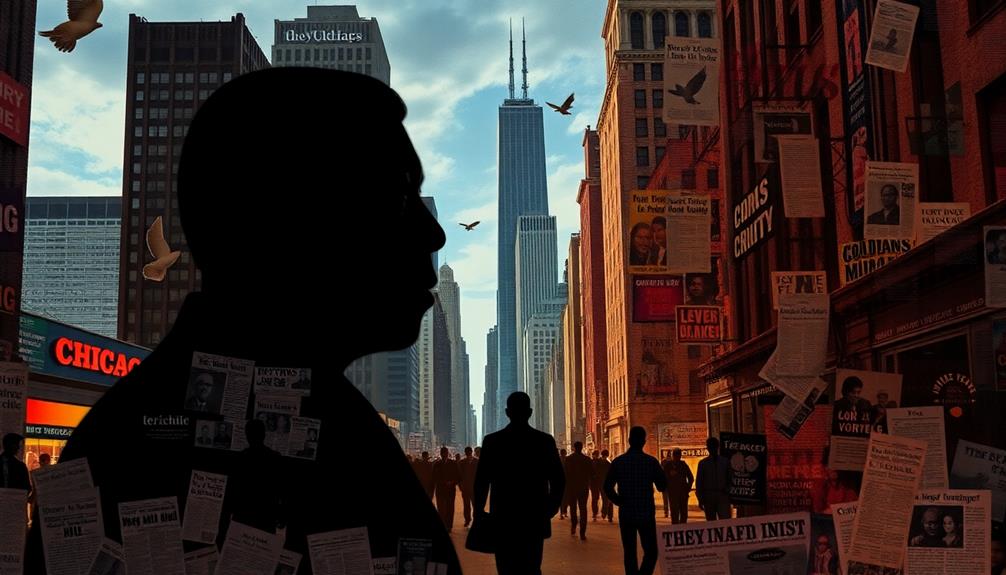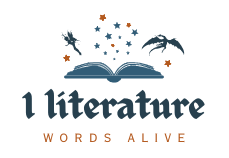Richard Wright, a visionary author, profoundly explored systemic racism in his landmark novel *Native Son*. You'll find that his life experiences, from growing up in Jim Crow Mississippi to migrating to Chicago, shaped his writing. The story of Bigger Thomas captures the isolation and despair faced by many African Americans in the 1930s. Wright's work sparked vital conversations about race, identity, and social justice that still resonate today. Its critical acclaim and cultural impact have made it a staple in literature courses. If you want to understand its legacy and significance further, there's much more to uncover about Wright's influence.
Overview of Richard Wright
Born into hardship in Mississippi, Richard Wright emerged as an essential voice in American literature. He faced fierce challenges from an early age, marked by poverty and the oppressive realities of Jim Crow laws.
In 1927, seeking a better life, you might find him migrating to Chicago during the Great Migration, where he began to cultivate his literary career while becoming involved with leftist political movements, including the Communist Party. Wright's experiences in this racially charged environment profoundly influenced his writing, particularly in his exploration of systemic oppression and its impact on marginalized individuals.
Wright's first major work, *Uncle Tom's Children*, published in 1938, tackled themes of racial violence and oppression, establishing him as a significant figure in literature.
However, it was his groundbreaking novel *Native Son*, published in 1940, that truly captured national attention. Featuring the character Bigger Thomas, a black man maneuvering through a world rife with systemic racism, the novel sold 250,000 copies and explored the psychological effects of racial oppression on African Americans.
Despite facing criticism for his raw depictions of race relations, Richard Wright's powerful storytelling continues to resonate. His influence on subsequent generations of writers and social activists remains undeniable, ensuring his place as a pivotal figure in American literature.
Background of "Native Son"
"Native Son" emerged in a pivotal moment of American history, reflecting the racial tensions of the 1930s.
As you explore its themes, you'll see how Richard Wright powerfully critiques systemic racism through the life of Bigger Thomas.
The novel's impact was immediate, sparking discussions that continue today about race relations and societal structures.
This work resonates with contemporary narratives, much like Ta-Nehisi Coates' exploration of systemic racism and historical legacies, highlighting the enduring struggle against oppression.
Author's Historical Context
In the tumultuous landscape of 1930s America, Richard Wright crafted "Native Son" against a backdrop of systemic racism and economic despair. Growing up in the Jim Crow South, Wright's life was steeped in poverty and racial discrimination, experiences that deeply informed his writing.
When you explore "Native Son," you witness the struggles of Bigger Thomas, a young African American man grappling with the harsh realities of life in 1930s Chicago. Wright's portrayal of racism and isolation reflects the historical tensions faced by African Americans during that era.
The novel does more than tell a story; it serves as a stark commentary on the societal constraints that shaped the lives of many. While "Native Son" received critical acclaim for its groundbreaking depiction of race relations, some critics argued it reinforced negative stereotypes of black individuals, sparking intense discussions about representation and identity.
Despite the controversy, the book's impact was undeniable, selling 250,000 copies within three weeks of its release. This success highlighted the urgent need for conversations about race and social justice in America, marking a pivotal moment in literary history.
Racial Themes Explored
The exploration of racial themes in "Native Son" reveals the deep-seated impact of systemic racism on Bigger Thomas's life. Published in 1940, Richard Wright's novel reflects the racial tensions of 1930s Chicago, illustrating how societal expectations shape Bigger's identity and choices.
You see how systemic racism contributes to his sense of isolation, leaving him alienated from both white and black communities. This alienation drives Bigger to desperate and violent actions, serving as a powerful manifestation of his fear and hopelessness in an oppressive society.
Wright challenges you to confront uncomfortable truths about race relations, highlighting the destructive cycle of oppression that affects not just Bigger but also the broader community.
As you explore the narrative, you encounter moral ambiguity, where Bigger's actions elicit both revulsion and sympathy. His struggle for survival in a hostile environment prompts you to examine the complexities of humanity within a context of racism.
Ultimately, "Native Son" doesn't just tell Bigger's story; it compels you to reflect on the lingering impacts of oppression and the urgent need for a more profound understanding of race relations in America.
Critical Reception Overview
Often hailed as a groundbreaking work, "Native Son" considerably impacted literary discussions around race and identity in America. Published in 1940, Richard Wright's novel received critical acclaim for its unflinching portrayal of racial tensions and systemic oppression, marking a significant contribution to the Harlem Renaissance.
The book quickly became a bestseller, selling 250,000 copies in just three weeks, underscoring its profound influence on American literary culture.
Critics praised "Native Son" for its raw depiction of the African American experience, yet some argued it reinforced negative stereotypes about black individuals.
The novel's exploration of themes such as:
- Isolation and its consequences
- Violence as a response to oppression
- Moral ambiguity in a racially charged society
sparked extensive debates about race relations and social justice, making it a staple in academic discussions.
Despite facing censorship in educational settings due to its graphic content, "Native Son" remains essential for understanding the complexities of race and identity in America.
Its legacy endures, as it challenges readers to confront uncomfortable truths about racism and society.
Plot and Character Analysis

In "Native Son," you witness Bigger Thomas's transformation as he grapples with his fear and anger in a society that marginalizes him.
This struggle echoes the historical significance of resistance movements, where individuals faced oppression with courage and resilience, exemplifying the same spirit of defiance against societal constraints.
The key relationships he forms, particularly with Mary Dalton and Bessie Mears, illuminate his isolation and desperation.
As you explore these dynamics, you'll uncover the profound themes of identity and morality that shape his tragic journey, much like the enduring hope seen in acts of courage from past resistance efforts.
Bigger Thomas's Transformation
Bigger Thomas's transformation in "Native Son" is a striking journey through fear, anger, and desperation shaped by systemic oppression. As a 20-year-old living in poverty in 1930s Chicago, you witness Bigger grappling with feelings of isolation and the weight of societal expectations.
His violent actions, starting with the accidental killing of Mary Dalton and later the murder of Bessie Mears, stem from a desperate need for agency. This transformation highlights three essential aspects:
- Confrontation with Identity: Bigger struggles to understand who he's in a world that dehumanizes him.
- Impact of Systemic Racism: His actions are a direct response to the oppressive environment that limits his options and traps him in a cycle of violence.
- Moral Ambiguity: As Bigger becomes aware of his choices, he wrestles with the moral implications of his survival in a racially oppressive society.
Ultimately, Bigger's imprisonment forces him to confront his reality, revealing the profound consequences of his transformation.
Key Relationships Explored
The exploration of key relationships in "Native Son" reveals the intricate web of connections that shape Bigger Thomas's identity and actions. His interactions with Mary Dalton and Jan Erlone lay bare the complexities of racial dynamics in 1930s Chicago. You sense Bigger's conflicting emotions of guilt, fear, and a desperate desire for acceptance as he navigates these relationships.
The Daltons represent a misguided form of white liberalism, with Mr. Dalton's superficial kindness failing to grasp the depths of Bigger's systemic oppression. Bigger's relationship with Bessie Mears reflects his internal struggles and growing isolation. Ultimately, his desperation leads to tragedy as he kills her to eliminate a witness, highlighting the devastating consequences of his choices.
Meanwhile, Jan Erlone's genuine friendship offers a glimpse of potential solidarity across racial lines, yet it starkly contrasts with the ingrained prejudices of the Daltons. Bigger's tumultuous connection with his own family further emphasizes his feelings of disconnection and alienation.
These key relationships illustrate how systemic forces impact individual lives, revealing the profound isolation that Bigger experiences as he grapples with his identity amidst societal constraints.
Themes of Isolation
Isolation permeates Richard Wright's "Native Son," with Bigger Thomas caught in a relentless struggle against disconnection from both the white and black communities. His chaotic life reflects the harsh realities of systemic oppression, leading to profound alienation.
As you follow Bigger's journey, you'll see how his isolation manifests in several ways:
- Symbolism of the Rat: In Book One, "Fear," the rat symbolizes Bigger's struggle against societal constraints, mirroring his feelings of entrapment and disconnection.
- Desperation and Violence: In Book Two, "Flight," Bigger commits violent acts, including the murder of Bessie, driven by his need to escape his isolation and assert a sense of agency.
- Silent Suffering: By Book Three, "Fate," Bigger's silence in prison underscores his internalized loneliness, showing his inability to connect even in discussions about race.
Wright's portrayal of Bigger's tragic fate serves as a critique of the systemic forces that contribute to his alienation.
You'll realize that Bigger's isolation isn't just personal; it's a reflection of societal constraints that trap individuals like him in a cycle of despair.
Major Themes Explored
Richard Wright's exploration of major themes in "Native Son" probes deep into the complexities of racism and systemic oppression. This work resonates with the experiences of other marginalized individuals, echoing the stories of hidden heroes who faced similar struggles against societal forces.
You'll see how societal structures shape Bigger Thomas's identity and choices, reflecting the intense racial tensions of 1930s America. Bigger's experience of isolation and alienation from both white and black communities underscores his profound loneliness, even in crowded spaces.
Wright vividly depicts violence and desperation, showing how Bigger's criminal actions stem from fear and societal pressures. This violence highlights the impact of systemic oppression on marginalized individuals like Bigger, whose choices often occur under extreme duress.
The theme of moral ambiguity runs throughout the narrative; as you follow Bigger's journey, you'll grapple with the irreversible consequences of his decisions and their moral implications.
Wright also weaves in biblical allusions, particularly from the Book of Job, to echo Bigger's suffering and despair. These elements culminate in a powerful commentary on existential struggle and societal rejection.
Ultimately, "Native Son" challenges you to confront the harsh realities of racism, isolation, and the oppressive forces that shape lives in profound and often tragic ways.
Cultural Impact and Controversies

Wright's "Native Son" not only explores profound themes but also reverberates throughout American culture, igniting discussions and controversies since its release. This groundbreaking novel, selling 250,000 copies within three weeks of publication, has become a touchstone for conversations about race and oppression, much like how acts of defiance against tyranny are illustrated in literary works such as "The Book Thief."
The cultural impact of "Native Son" can be summarized in three key areas:
- Censorship: The novel faced challenges in educational settings due to its graphic content, ranking 71st on the ALA's list of frequently challenged books from 1990 to 2000.
- Systemic Racism: Wright's portrayal of Bigger Thomas has led to debates over whether he reinforces negative stereotypes or critiques systemic racism.
- Religious Critique: The inclusion of biblical allusions in the narrative reflects Wright's critical perspective on religion's role in perpetuating social injustices, particularly through Bigger's struggles.
These controversies highlight the power of "Native Son" to provoke thought and discussion about societal issues, making it an essential work in understanding the complexities of race and oppression in America.
Wright's novel continues to resonate, challenging readers to confront uncomfortable truths.
Legacy and Influence on Literature
In the wake of its release, *Native Son* reshaped the landscape of American literature, pushing boundaries and challenging norms. Richard Wright's groundbreaking novel quickly became a bestseller, selling 250,000 copies in just three weeks. It set a precedent for raw portrayals of race, focusing on the struggles and brutality faced by African Americans rather than romanticized depictions.
The book's profound impact can be traced back to Wright's early life experiences, which were marked by poverty and segregation that deeply influenced his worldview. The complex protagonist, Bigger Thomas, has influenced generations of writers, prompting deep discussions on systemic racism, violence, and identity within African American literature.
Wright's work opened doors for other authors, like James Baldwin and Ralph Ellison, to explore themes of racial oppression in their own narratives. Their contributions continue to build on the foundation Wright established, expanding the literary conversation around race and identity.
The cultural significance of *Native Son* endures, remaining an essential text in discussions about race relations and social justice, both in academic settings and popular culture. By challenging existing norms and highlighting the harsh realities of black life, Richard Wright's influence echoes through the works of countless authors, ensuring that the struggles portrayed in *Native Son* resonate in today's literary landscape.
Critical Reception and Analysis

Upon its release in 1940, *Native Son* garnered significant critical acclaim, quickly establishing itself as a pivotal work in American literature. Selling 250,000 copies in just three weeks, it became the first book by an African American author selected by the Book of the Month Club. The novel's raw portrayal of racial tensions and systemic oppression resonated deeply, making a lasting impact.
In a manner reminiscent of narratives that explore the complexities of human experience and societal challenges, such as those found in the triumph of the human spirit, Wright's work reveals the profound psychological effects of systemic racism on individuals.
However, it's crucial to contemplate both praise and criticism surrounding the book. Critics have noted that:
- Wright's depiction of Bigger Thomas highlights the psychological impact of systemic racism.
- Some argue that the novel reinforces negative stereotypes of Black individuals through its portrayal of violence.
- Despite this, the themes of social justice remain relevant, influencing contemporary discussions on race relations.
*Native Son* continues to be a staple in academic curricula, even facing censorship challenges in schools.
Ultimately, its exploration of Bigger's struggle serves as a powerful commentary on race, identity, and morality in American society, ensuring its place in critical studies and discussions for years to come.
Conclusion
In the shadow of literary giants, Richard Wright's "Native Son" stands as a powerful beacon of social commentary. Just as Gatsby's green light symbolized unattainable dreams, Bigger Thomas embodies the struggle against systemic oppression. You can't help but feel the weight of Wright's vision, urging you to confront uncomfortable truths about race and identity. As you close the book, you're left pondering how far we've come—and how far we still have to go in the pursuit of true equality.



